How Long Does the Average Employer Spend Reviewing a Cover Letter
What is the boilerplate number of applicants per task? How much does it cost to hire someone? How long does the recruitment process have?
Wouldn't it be helpful if in that location was a collection of recruiting and job statistics all in one place?
Breaking down the job hunt into numbers is tricky business—
One report says hundreds of talented people are going after the same task. Another is full of recruitment statistics that "prove" there isn't a single talented person out there.
And who has fourth dimension to enquiry all the human resource and hiring statistics anyhow?
We do!
Whether you lot're a recruiter or a job seeker, we've put together the best, about recent human resource stats out there and then you can run across what the job search looks like in numbers.
We'll testify you:
- The ultimate drove of up-to-date hiring and recruitment statistics and facts.
- Contempo 60 minutes trends and developments.
- Charts and visuals, which you're free to utilize.
List of Job Search and Human Resource Statistics:
1. Well-nigh Pop Statistics
two. Job Search Statistics
iii. Recruiting and Hiring Statistics
4. Resume Statistics
5. Task Interview Statistics
half dozen. Millennial Recruitment Statistics
7. Online and Social Media Recruitment Statistics
8. Employer Branding Statistics
9. Variety Statistics
10. Mobile Recruiting Statistics
11. Students and Contempo Graduates Statistics
1
25 Most Of import Human Resource Statistics
- 96% of job seekers say that it's important to work for a company that embraces transparency.
(Glassdoor U.S. Site Survey, 2017)
- 79% of task seekers say they are likely to use social media in their job search and this increases to 86% for younger task seekers.
(The Open up University, 2019)
- On average, each corporate job offer attracts 250 resumes. Of those candidates, 4 to 6 will go called for an interview, and only one volition get the job.
(Glassdoor)
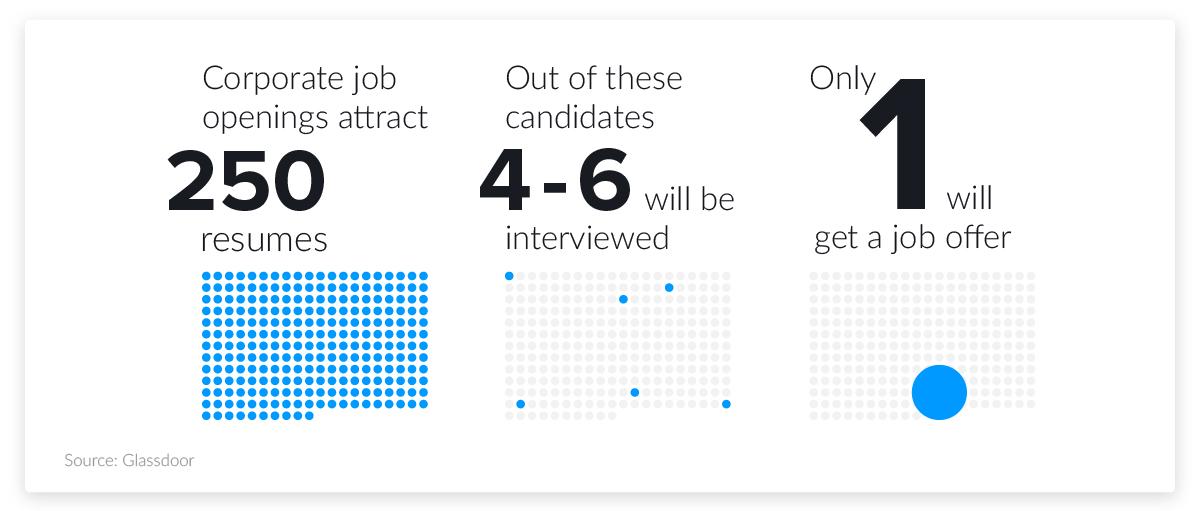
- ane in 6 candidates who applied for a job were asked for an interview.
(Jobvite 2017 Recruiting Funnel Benchmark Report)
- Recruiters take an average of vi seconds to scan a resume.
(TheLadders)
- 87% of recruiters utilise LinkedIn to bank check candidates.
(Jobvite Recruiter Nation Written report 2016)
- After finding a task opening, 64% of candidates said they research a visitor online and 37% said they volition move on to another chore opening if they can't observe information on the company.
(Careerbuilder 2016)
- Superlative 5 pieces of data job seekers want employers to provide as they inquiry where to work:
○ Details on compensation packages
○ Details on benefits packages
○ Bones visitor information
○ Details on what makes the company an attractive place to work
○ Company mission, vision and values
(Glassdoor U.Due south. Site Survey, Jan 2016)
- 91% of employers prefer their candidates to have work feel, and 65% of them adopt their candidates to have relevant work experience.
(NACE Job Outlook 2017)
- 87% of Millennials rate professional career growth and developmental opportunities equally important to them in a task.
(Gallup 2016)
- Nearly eighty% of Millennials wait for people and culture fit with employers, followed by career potential.
(Collegefeed, March 2014)
- In 2015, 51% of those who did have jobs were searching for new ones or watching for openings.
(State of the American Workplace Report Gallup 2017)
- American Millennials are now more than likely to say they will stay 5+ years with a visitor than to leave inside ii years.
(2017 Deloitte Millennial Survey)
- Average time-to-hire a new employee was 39 days in 2016, down from 43 days in 2015.
(Jobvite 2017 Recruiting Funnel Benchmark Written report)
- 50% of candidates say they wouldn't piece of work for a company with a bad reputation - fifty-fifty for a pay increase.
(Betterteam Weblog 2017)
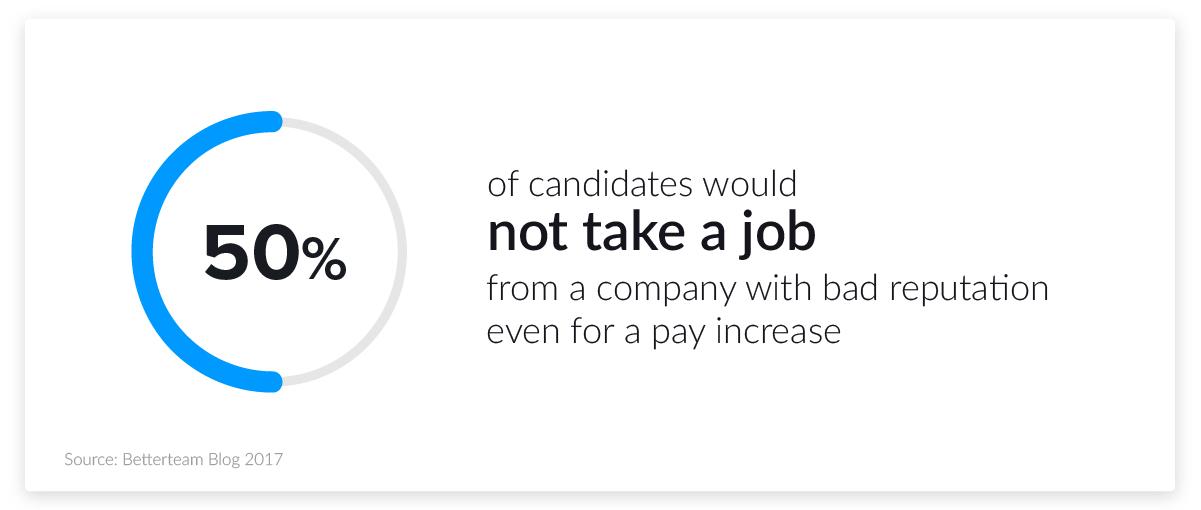
- 92% would consider leaving their current jobs if offered another role with a company that had an excellent corporate reputation.
(Corporate Responsibleness Magazine, September 2015)
- 69% of job seekers are likely to utilize to a job if the employer actively manages its brand.
(Glassdoor 2016)
- Boilerplate toll per hire statistics for companies is $4,129.
(SHRM Human Capital Benchmarking Report 2016)
- 33% of American workers are engaged at work vs. lxx% of workers at the world'south best organizations.
(State of the American Workplace Report Gallup 2017)
- 61% of employees say the realities of their new job differ from expectations set during the interview procedure.
(Glassdoor 2013)
- fourscore% of job seekers believe their companies foster diverseness at piece of work.
(Jobvite 2017 Task Seeker Nation Report)
- Ethnically diverse companies are 35% more likely to take a financial performance above the industry hateful.
(McKinsey 2015)
- 41% of US employers plan to use text messages to schedule chore interviews.
(Careerbuilder 2017)
- By 2016, simply 19% of recruiters were investing in a mobile career website.
(Jobvite Recruiter Nation Report 2016)
- 78% of 2017 grads completed an internship or apprenticeship.
(Gen Z Study Accenture 2017)
- 97% of 2017 grads said they will need on-the-job preparation to farther their careers.
(Gen Z Report Accenture 2017)
- In 2020 it'due south estimated that 35% of job openings required at least a bachelor'southward degree, 30% of job openings required some college or an associate's degree and 36% of job openings required no educational activity across high school.
(Georgetown University Center on Education and the Workforce 2020)
- The average number of jobs held in a lifetime is 12.5 for men and 12.1 for women.
(Agency of Labor Statistics)
- The number one reason why employees quit is a lack of appreciation at their current task. 79% of employees who quit claimed this was a major reason for leaving.
(O.C. Tanner 2019)
- 81% of employees would consider leaving their jobs for the right offering.
(Hays)
- Up to 85% of jobs are filled via networking.
(LinkedIn)
- Current unemployment rate in the U.S. is half dozen.7% with 10.7 million people looking for jobs.
(US Agency of Labor Statistics, November 2020)
- Long-term unemployed in the U.S. (longer than half dozen months) brand upwardly 36.9% of the unemployed at 3.9 meg.
(Bureau of Labor Statistics,November 2020)
- The average amount of time to find a job is 24weeks.
(Bureau of Labor Statistics, November 2020)
- It takes 100–200 job applications to get ane task offer
(TalentWorks, 2017)
- As of the last day of Oct 2020, there 6.7 million job openings available in the U.S.
(Agency of Labor Statistics, December 2020)
- The average length of a workweek was 38.7 hours in 2015, upwardly from 38.1 hours in 1980.
(The State of American Jobs Written report Pew Enquiry October 2016)
- On average, a full-time employee in the Us of America works 1,786 hours per year.
(OECD, 2019)
- Boilerplate number of weeks worked per year increased from 43 in 1980 to 46.8 in 2015. (Combined, it adds upwardly to an additional month of piece of work per year.)
(The State of American Jobs Report Pew Research October 2016)
- The average time at a job is 4.one years. That's the median number of years that wage and salary employees have been with their current employer.
(Bureau of Labor Statistics, Employee Tenure in 2020, September 2020)
- 59% of employees say they've been working with their electric current employer for more three years. And 22% of older millennials betwixt thirty and 37 accept been with their electric current employer for more than than vii years.
(Udemy)
- In 2015, 51% of those who did have jobs were searching for new ones or watching for openings.
(Country of the American Workplace Written report Gallup 2017)

- 89% of Glassdoor users are either actively looking for jobs or would consider better opportunities.
(Glassdoor U.S. Site Survey, January 2016)
- 87% of organizations cite civilization and engagement equally i of their top challenges, and 50% phone call the trouble "very important."
(Global Man Capital Trends 2015, Deloitte, February 2015)
- Current task satisfaction statistics for American workers:
○ Very Satisfied - 49%
○ Somewhat Satisfied - thirty%
○ Dissatisfied - ix%
○ Very Dissatisfied - half-dozen%
(The Land of the American Jobs Study Pew Enquiry October 2016)
- In 2014, 51% of workers had worked for their current employer for five+ years compared to 46% in 1996.
(The Land of American Jobs Report Pew Research October 2016)
- Job seekers will spend an average of 11 hours a calendar week looking for work.
(Careerbuilder)
- Only 12% of employees concur that their visitor does a good job of onboarding new employees.
(State of the American Workplace Report Gallup 2017)
- 33% of American workers are engaged at piece of work vs. seventy% of workers at the earth's best organizations.
(Country of the American Workplace Report Gallup 2017)

- In 2015, Millennials became the dominant demographic on the labor marketplace.
(Pew Research 2015)
- Millennials accept the highest rates of unemployment and underemployment.
(State of the American Workplace Written report Gallup 2017)
- Do workers think their credentials and qualifications match up with the requirements of their jobs?:
○ Overqualified - 41%
○ Qualified - 50%
○ Underqualified - ix%
(The State of American Jobs Study Pew Research Oct 2016)
- 68% of employees believe they are overqualified for their electric current job.
(State of the American Workplace Gallup 2017)
- 44% of recent grads found it difficult or extremely difficult to find a task.
(Gen Z Grads Course of 2017 Accenture)
- 49% of recent grads accepted a lower salary or compromised on benefits.
(Gen Z Grads Grade of 2017 Accenture)
- Jobs requiring social skills have grown 83%.
(The Land of the American Job Report Pew Inquiry October 2016)
- Jobs requiring belittling skills (computer / critical thinking) grew 77%.
(The Land of the American Task Report Pew Research October 2016)
- Jobs requiring both social and belittling skills have grown 94% since 1980.
(The State of the American Job Report Pew Enquiry October 2016)
Run into more chore search statistics: Task Search Statistics and Gig Economy Statistics
3
Recruiting and Hiring Statistics for Hr
- Meridian trends for the future of recruiting:
○ More Diverse Candidates - 37%
○ Focus on Soft Skills Assessment - 35%
○ Investment in Innovative Interviewing Tools - 34%
○ Company Mission Used as a Differentiator - 33%
○ Big Data - 29%
(LinkedIn Global Recruiting Trends 2017)
- 95% of recruiters say that hiring volition remain as competitive in 2017 as information technology was in 2015 and 2016.
(Jobvite Recruiter Nation Written report 2016)
- On boilerplate, each corporate chore offer attracts 250 resumes. The typical employer will then interview 4–6 candidates for the job, and but ane will be successful.
(Glassdoor)
- The average number of applicants per job opening was 29 in 2018, down from 36 in 2017 and 52 in 2016.
(Jobvite 2019 Recruiting Benchmark Report)
- 63% of recruiters say talent shortage is their biggest trouble.
(2017 Recruiter Sentiment Study MRI Network)
- Average time to hire a new employee was 39 days in 2016, down from 43 days in 2015.
(Jobvite 2017 Recruiting Funnel Benchmark Report)
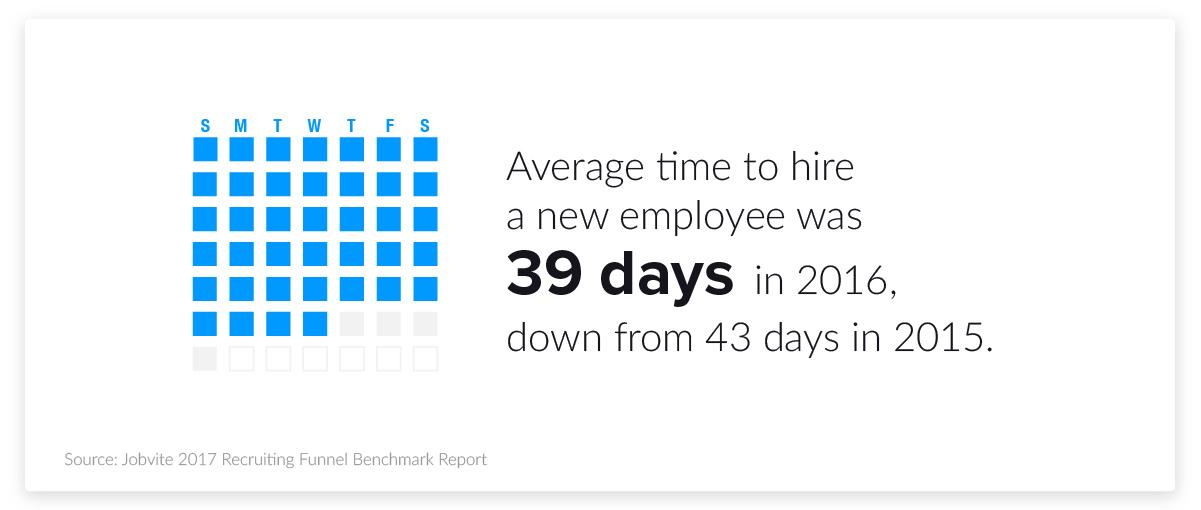
What barriers are there to identifying qualified talent?
- According to recruiters:
○ Not plenty suitable candidates - 63%
○ Candidates don't answer to calls and emails - 42%
○ Difficulty finding passive talent - 34%
○ Besides many unqualified junk resumes from chore boards - 23%
○ Other - xi%
(2017 Recruiter Sentiment Study MRI Network)
- In 2016, 56% of recruiters said they can't make skilful hires because of lengthy hiring procedures.
(2016 Recruiter & Employer Sentiment Survey MRI Network)
How many interviews earlier getting a job offering?
- According to recruiters:
○ Iii - 51%
○ Four - 22%
○ Two - 17%
○ Five or More - 9%
○ Ane - 1%
(2017 Recruiter Sentiment Study MRI Network)
- The recruitment process can be longer depending on screening methods:
○ Phone Interview - +6.8 - 8.two days
○ Group Panel Interview - +5.6 - half-dozen.8 days
○ One-on-1 Interview - +iv.1 - 5.3 days
○ Groundwork Check - +3.one - 3.4 days
○ Presentation - +two.seven - 4.2 days
○ IQ Exam - +ii.six - 4.iv days
○ Job Skills Examination - +0.half dozen - 1.5 days
○ Personality Test - +0.9 - one.3 days
○ Drug Exam - +0.3 - 0.8 days
(Glassdoor)
- Where do hires come up from? Which source is used almost for job searching and recruiting? Here are the top 5 sources:
○ Career Sites - 27.35%
○ Job Boards - 18.76%
○ Referrals - 15.83%
○ Internal Rent - 15.25%
○ Bureau - iv.52%
(Jobvite 2017 Recruiting Funnel Benchmark Report)
- Where are applications coming from? Hither are the top five sources:
○ Job Boards - 52.17%
○ Career Sites - 33.90%
○ Referrals - 3.07%
○ Internal Hire - two.26%
○ Agency - 1.76%
(Jobvite 2017 Recruiting Funnel Criterion Study)
- Internal hiring is 6x more effective than all other sources of hiring.
(Jobvite 2017 Recruiting Funnel Benchmark Report)
- Referrals are 5x more than effective than all other sources of hiring.
(Jobvite 2017 Recruiting Funnel Benchmark Report)
- 46% of employees hired through referral programs stay for three years or more, while merely 14% of those hired through job boards stay.
(Jobvite Index)
- Referrals are hired 55% faster than those hired through a career site.
(Jobvite Index)
- To go quality referrals, 64% of recruiters report awarding monetary bonuses as incentive.
(Jobvite Recruiter Nation Written report 2016)
- Average conversion charge per unit of career websites visitors to applicants - 8.59% in 2016, downwards from eleven% in 2015.
(Jobvite 2017 Recruiting Funnel Criterion Report)
- In 2016, i in 6 candidates who applied for a job were asked for an interview.
(Jobvite 2017 Recruiting Funnel Criterion Written report)
- The average conversion charge per unit from interview to offer - nineteen.78% in 2016 translating to five interviews per offer.
(Jobvite 2017 Recruiting Funnel Benchmark Report)
- The conversion rate of offers accustomed - 83.ane% in 2016, down from 89% in 2015.
(Jobvite 2017 Recruiting Funnel Criterion Report)
- The average time from interview to job offering is 20–40 days, depending on your manufacture and location.
(Jobvite 2018 Recruiting Benchmark report and Glassdoor Time to Rent written report 2017)
Why are job offers rejected?
- According to recruiters:
○ Accepted Another Offering - 32%
○ Compensation - 25%
○ Took Counteroffer - xv%
○ Lengthy Hiring Process - 11%
○ Other - six%
○ No Rejection - 5%
○ Limited Promotion or Career Pathing - 2%
○ No Flexible Scheduling - 2%
○ Inadequate or No Relocation Package - ii%
(2017 Recruiter Sentiment Study MRI Network)
- According to candidates:
○ No Offer Was Rejected - 40%
○ Compensation - 27%
○ Accepted Another Offer - 12%
○ Limited Promotion or Career Pathing - 6%
○ No Flexible Scheduling - 6%
○ Other - half dozen%
○ Also Long Ago to Remember - ii%
○ Inadequate or No Relocation Package - i%
○ Took Counteroffer - 0%
○ Lengthy Hiring Process - 0%
(2017 Recruiter Sentiment Report MRI Network)
How many interviews before a chore offer was rejected?
- According to recruiters:
○ Three - 45%
○ Two - 20%
○ Four - 17%
○ No Rejections - 10%
○ 1 - 4%
○ Five or More - 4%
(2017 Recruiter Sentiment Report MRI Network)
How much time passed between the first interview and a rejected offer?
- According to recruiters:
○ 5-8 Weeks - 46%
○ ane-4 Weeks - 39%
○ No Rejections - 10%
○ 9+ Weeks - v%
(2017 Recruiter Sentiment Study MRI Network)
- Candidates don't want to complete an application that volition take longer than twenty minutes.
(Careerbuilder)
- 76% of job seekers want to know how long information technology's going to take to fill out an application earlier they start.
(Careerbuilder)
- 66% of chore seekers said they would await merely two weeks for a callback after which they consider the job a lost cause and motility on to other opportunities.
(Careerbuilder)
- Average cost per rent for companies is $4,129.
(SHRM Human Capital Benchmarking Study 2016)
- The average cost of a bad hire is upward to 30% of the earnings of the employee in the first yr co-ordinate to the Department of Labor. But a report from one CEO put the price equally high as $240,000. (Usa Department of Labor and Jörgen Sundberg, CEO of Link Humans)

What is most attractive to prospective hires? Visitor culture statistics.
- According to recruiters:
○ Advocacy Opportunities - 72%
○ Better Compensation Packages - 64%
○ Improved Work-life Balance - 58%
○ Better Company Civilisation - 37%
○ Fun Company Civilization - 11%
○ Collaborative Surroundings - 10%
○ Access to Emerging Tech - viii%
○ Other - 7%
○ Training / Continued Education - 5%
○ Sense of Esprit - two%
(2017 Recruiter Sentiment Study MRI Network)
- According to candidates:
○ Competitive Compensation Packages - 52%
○ Emphasis on Work-life Residue - 38%
○ Advancement Opportunities - 31%
○ Collaborative Environment - 29%
○ Training / Continued Education - 27%
○ The Organization'south Ethics - 27%
○ Piece of work From Dwelling Options - 25%
○ Ease of Commute - 21%
○ Fun Visitor Civilization - 17%
○ Access to Emerging Tech - sixteen%
○ Sense of Camaraderie - 10%
○ Other - 3%
(2017 Recruiter Sentiment Report MRI Network)
- Common benefits and perks that companies offer:
○ Paid Vacation - 92%
○ Health Insurance - 91%
○ Paid Get out - 86%
○ Other Insurance Coverage - 82%
○ Retirement Programme - 68%
○ Wellness Program - 58%
○ Reimbursement of Conference Fees - 57%
○ Professional Evolution Programs - 57%
○ Employee Help Programs - 56%
○ Company Perks (Discounts, Paid Memberships) - 55%
○ Free or Subsidized Parking or Transportation Passes - 50%
(State of the American Workplace Gallup 2017)
- How important are piece of work from dwelling options for candidates?
○ Somewhat - 37%
○ Not Very - 28%
○ Non At All - 18%
○ Extremely - 18%
(2017 Recruiter Sentiment Study MRI Network)
- Tiptop 5 pieces of information job seekers want employers to provide as they research where to piece of work:
○ Details on Bounty Packages
○ Details on Benefits Packages
○ Basic Visitor Information
○ Details on What Makes the Visitor Attractive
○ Company Mission, Vision, Values
(Glassdoor U.s.a. Site Survey January 2016)
- What task seekers expect to find on a job clarification:
○ Bacon - 74%
○ Full Benefits Parcel - 61%
○ Employee Ratings - 46%
○ Contact Info of Hiring Director - forty%
○ Piece of work From Domicile Options - 39%
○ Clarification of Work / Life Balance - 35%
○ Photos / Videos of the Piece of work Surround - 31%
○ Descriptions of Squad Structures and Hierarchies - 27%
○ Number of People Who've Applied - 25%
(Careerbuilder)
- 90% of job seekers say that it's important to work for a company that embraces transparency.
(Glassdoor U.S. Site Survey, January 2016)
- 76% want details on what makes the company an attractive place to piece of work.
(Glassdoor survey, Oct 2014)
- 61% of job seekers say they would go out their task for health insurance.
(Country of the American Workplace Gallup 2017)
- 92 percent would consider leaving their current jobs if offered another role with a company that had an fantabulous corporate reputation.
(Corporate Responsibility Magazine, September 2015)
- 53% of employees who get paid vacation would leave for more than at another company.
(Country of the American Workplace Gallup 2017)
- l% of employees with retirement plans would leave for a ameliorate retirement plan.
(Country of the American Workplace Gallup 2017)
- 48% of employees who become paid get out would leave for more than paid leave.
(State of the American Workplace Gallup 2017)
- 35% of employees would change jobs for a flexible working location (off-site full fourth dimension), merely 12% of companies offer it.
(State of the American Workplace Gallup 2017)
- twoscore% of employees would modify jobs for profit sharing, xx% say companies offer it.
(State of the American Workplace Gallup 2017)
- 51% of employees would alter jobs for a retirement plan with a divers pension, 43% say companies offer it.
(State of the American Workplace Gallup 2017)
- 51% of employees would alter jobs for flextime, 44% say their company offers it.
(Land of the American Workplace Gallup 2017)
- Real price of employee turnover:
○ Entry-level Employees - between 30-50% of the annual bacon to supervene upon them.
○ Mid-level Employees - up of 150% of their almanac bacon to supervene upon them.
○ High-level or Highly Specialized Employees - 400% of their annual salary.
(ERE)
Read Zety'south unique Candidate Experience Survey of i,000+ job seekers.
- Hither'southward what recruiters say will get a resume rejected in 2016:
○ Impersonal Applications (No Hiring Manager'southward Name) - 84%
○ No Thanks Note After Interview - 57%
○ Resumes Aren't Customized and Tailored - 54%
○ No Comprehend Letter - 45%
○ No Follow Up With Employer After Interview - 37%
(Careerbuilder)
- What recruiters say they look for on a resume:
○ Job Experience - 67%
○ Cultural Fit - 60%
○ Cover Messages - 26%
○ Prestige of College - 21%
○ GPA - 19%
(Jobvite Recruiter Nation Report 2016)
- On average, each corporate task offer attracts 250 resumes. Of those candidates, 4 to vi will get called for an interview, and merely one will get the job.
(Glassdoor)

- 62% of employers are specifically looking for your soft skills.
(Careerbuilder)
- 93% of employers consider soft skills an "essential" or "very of import" cistron in hiring decisions.
(Wonderlic.)
- 42% of job seekers say that expanding their skill prepare is a top priority when choosing an employer.
(Udemy)
Larn more almost skills employers look for .
- What recruiters wait for in job seekers:
○ Resumes Tailored to the Open Position - 63%
○ Skill Sets Listed First on a Resume - 41%
○ Cover Letters - 40%
○ Application Addressed to the Hiring Manager - 22%
○ Links to Personal Blogs, Portfolios, or Websites - sixteen%
(Careerbuilder)
- Recruiters take an average of six seconds to scan a resume.
(TheLadders)

- Not using your professional skills can hurt a resume as much every bit one twelvemonth of unemployment. The damage is limited for those who had temp agency employment.
(American Sociological Review)
- 80.4% of resumes errors come from mistakes in one-time job experience descriptions.
(TheLadders)
- 71.six% of resume errors come from the miscommunication of skills on a resume.
(TheLadders)
- 68.7% of resume errors involved missing accomplishments.
(TheLadders)
- 75% employers caught a lie on a resume.
(CareerBuilder, 2018)
- The typical job seeker writes merely i resume in their job search. Typically, it'southward ane folio long.
(Zety, 2020)
See Zety'southward complete study of 133,000 resumes for more than: Resume Statistics
five
Job Interview Statistics
- The boilerplate conversion rate from interview to offer was nineteen.78% in 2016, translating to 5 interviews per offering.
(Jobvite 2017 Recruiting Funnel Criterion Study)
- The average interview procedure length in the US was 27.5 days in 2019.
(CMD Recruitment)
- In 2016, 1 in 6 candidates who applied for a chore were asked for an interview.
(Jobvite 2017 Recruiting Funnel Benchmark Report)
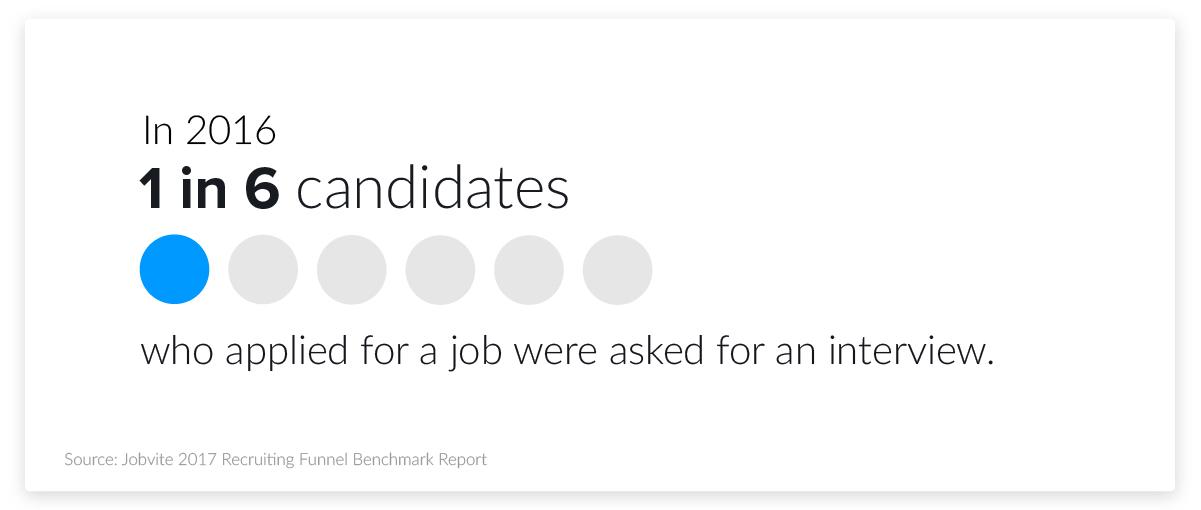
How many interviews come up before a job offering?
- According to recruiters:
○ Three - 51%
○ Four - 22%
○ Two - 17%
○ 5 or More - nine%
○ Ane - ane%
(2017 Recruiter Sentiment Study MRI Network)
- Conducting a phone Interview can add together 6.viii - 8.ii days to the recruitment process.
(Glassdoor 2015)
- Conducting a group console interview tin can add 5.vi - 6.eight days to the recruitment procedure.
(Glassdoor 2015)
- Conducting a i-on-one interview can add iv.ane - 5.3 days to the recruitment process.
(Glassdoor 2015)
How long does it take between an interview and a chore offering?
- According to recruiters the interview-to-offer timeline is most often iii to six weeks:
○ 5-6 Weeks - 35%
○ 3-four Weeks - 31%
○ 7-8 Weeks - 23%
○ 1-2 Weeks - 8%
○ ix+ Weeks - 3%
(2017 Recruiter Sentiment Study MRI Network)
How many interviews happen earlier a job offer is rejected?
- According to recruiters:
○ Three - 45%
○ Two - 20%
○ Four - 17%
○ No Rejections - 10%
○ One - 4%
○ 5 or More - iv%
(2017 Recruiter Sentiment Report MRI Network)
How much fourth dimension passed between the kickoff interview and a rejected offer?
- According to recruiters:
○ 5-8 Weeks - 46%
○ 1-four Weeks - 39%
○ No Rejections - 10%
○ 9+ Weeks - 5%
(2017 Recruiter Sentiment Study MRI Network)
- 61% of employees say the realities of their new job differ from expectations gear up during the interview procedure.
(Glassdoor 2013)
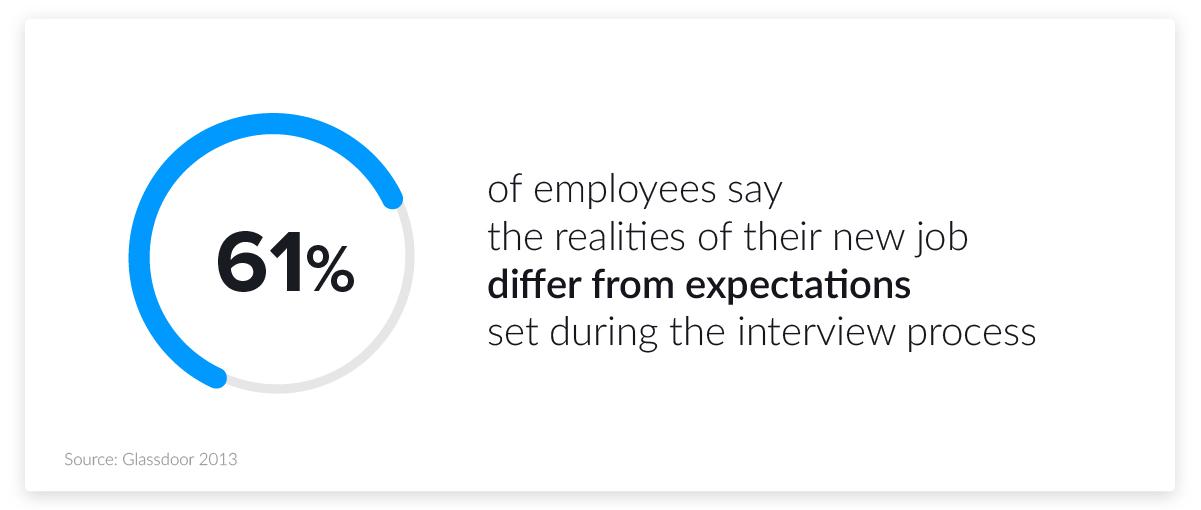
- 41% of employers say that they might not interview a candidate if they can't find them online.
(Careerbuilder)
- A 10% harder interview process is associated with two.half dozen% higher employee satisfaction later.
(Glassdoor 2015)
- 34% of recruiters list investment in innovative interviewing tools as a acme tendency for the most hereafter.
(LinkedIn Global Recruiting Trends 2017)
- The most pop interview technique is structured interviews, used frequently by 74% of HR professionals. This is followed by behavioral interviews (73%), phone screening (57%), and panel interviews (48%). (LinkedIn Glocal Recruiting Trends 2018)
Read our reasearch on Height Qualities and Traits Employers Look for in 2022
6
Millennials Recruitment Statistics
- Millennials make upward 38% of the American workforce, on rails for upward to 75% by 2025.
(Gallup 2016)
- Millennials have the highest rates of unemployment and underemployment.
(Gallup State of the American Workplace Report 2017)
- 71% of Millennials say they're not engaged or are actively disengaged at work.
(Gallup 2016)
- Estimates show that Millennial turnover due to poor engagement costs the The states economy $30.5 billion a year.
(Gallup 2016)
- Millennials change jobs an average of four times in their get-go decade out of college.
(LinkedIn 2016)
What methods and tools appoint and retain Millennials?
- According to Recruiters:
○ Ability to Work from Home - 38%
○ Career Pathing - 32%
○ Cool Engineering - 23%
○ Non Applicative - eighteen%
○ Company Perks - 17%
○ Open Floor Plans - fourteen%
○ Mobile over Desktop - xiii%
○ Internal Social Sharing Platforms - 10%
○ Groups Devoted to Mentoring and Diverseness - nine%
○ Other - 3%
(2017 Millennial Hiring Trends Written report MRI Network)
- 60% of Millennials (United states of america) say they're open to different job opportunities.
(Gallup 2016)
- Yet, American Millennials are at present more likely to say they will stay five+ years with a company than to go out within ii years.
(2017 Deloitte Millennial Survey)
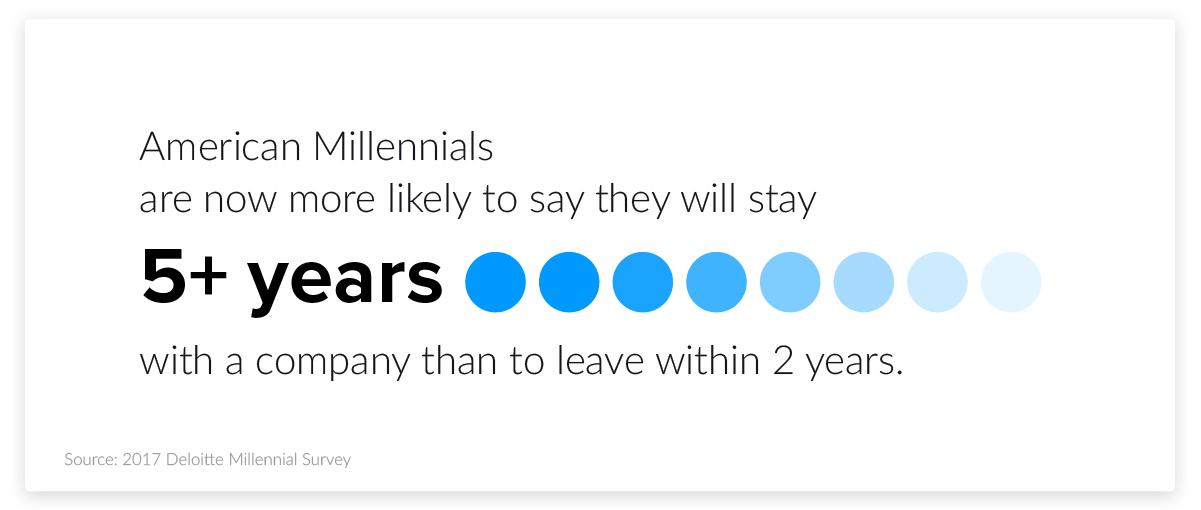
- In 2016, 64% of US Millennials planned on leaving their jobs in the next 5 years.
(2016 Deloitte Millennial Survey)
- What will Millennials change their job for?:
○ Paid Holiday - 64%
○ Flextime - 63%
○ Other Insurance Coverage - 60%
○ Flexible Location (Off-site Role Time) - fifty%
○ Flexible Location (Off-site Total Fourth dimension) - 47%
○ Student Loan Reimbursement - 45%
○ Tuition Reimbursement - 45%
○ Paid Motherhood Leave - 44%
○ Paid to Work on Independent Project - 42%
○ Professional Development Programs - 41%
○ Paid Paternity Go out - 37%
○ Kid Care Reimbursement - thirty%
(Gallup Country of the American Workplace Report 2017)
- 38% of Millennials worldwide plan on leaving their jobs inside ii years, down from 44% in 2016.
(2017 Deloitte Millennial Survey)
- 31% of Millennials worldwide plan on staying 5+ years in their job, up from 27% in 2016.
(2017 Deloitte Millennial Survey)
- 7% of Millennials worldwide say they volition "leave soon," downwards from 17% in 2016.
(2017 Deloitte Millennial Survey)
What are the top channels used to attract Millennials?
- According to Millennials:
○ Marketplace Reputation (Employer Make) - 40%
○ Goodwill/Customs Outreach - xvi%
○ Employee Ambassadors - fifteen%
○ Online Presence - 12%
○ Quick Mobile-apply Process - 11%
○ Other - 6%
(2017 Millennial Hiring Trends Written report MRI Network)
What is most of import to Millennials?
- According to Millennials:
○ Bounty and Benefits - 28%
○ Mentorship - 26%
○ Opportunities for Advocacy - 26%
○ Sense of Purpose from Piece of work - sixteen%
○ Work-life Balance - 16%
○ Flexible Arrangements (Remote Work) - v%
○ Fun Company Culture - iii%
○ Teams - 2%
○ Other - 2%
○ Company Perks - 1%
○ Cutting-edge Technology - 1%
(2017 Millennial Hiring Trends Study MRI Network)
- 50% of Millennials say they'd consider taking a job with a different company for a raise of 20% or less.
(Gallup 2016)
- 87% charge per unit professional career growth and developmental opportunities as important to them in a job.
(Gallup 2016)
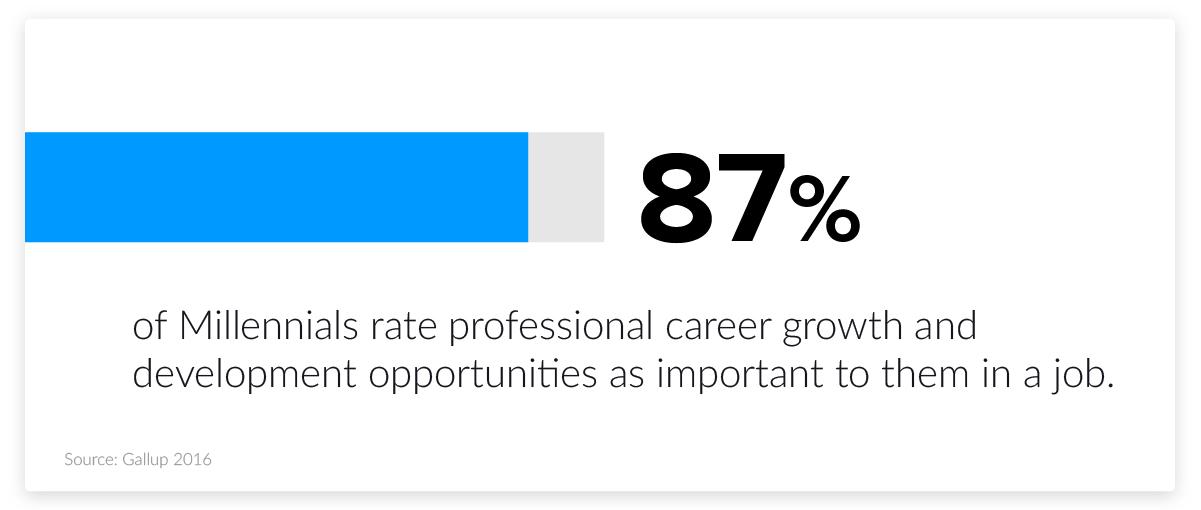
- Nearly fourscore% of Millennials await for people and civilisation fit with employers, followed past career potential.
(Collegefeed, March 2014)
- 45% of Millennials rate professional person career growth as "very important" to them as opposed to 31% of GenXers and 18% of Babe Boomers.
(Gallup State of the American Workplace Report 2017)
- 65% of Millennials prefer full time employment every bit information technology offers them "job security" and a "stock-still income."
(2017 Deloitte Millennial Survey)
- Ii thirds of Millennials have employers with flexible arrangements - 69% with flexible working hours and 68% with flexible roles.
(2017 Deloitte Millennial Survey)
- 61% of Millennials believe GenZ will accept a positive impact on the workplace.
(2017 Deloitte Millennial Survey)
- In 2015, Millennials became the ascendant demographic on the labor market place.
(Pew Research 2015)
- What will Millennials change jobs for?:
○ Paid Holiday - 64%
○ Flextime - 63%
○ Other Insurance Coverage - 60%
○ Flexible Location (Off-site Part Time) - 50%
○ Flexible Location (Off-site Full Fourth dimension) - 47%
○ Student Loan Reimbursement - 45%
○ Tuition Reimbursement - 45%
○ Paid Maternity Leave - 44%
○ Paid to Work on Independent Project - 42%
○ Professional Evolution Programs - 41%
○ Paid Paternity Leave - 37%
○ Kid Intendance Reimbursement - xxx%
(State of the American Workplace Gallup 2017)
- Millennials have the highest rates of unemployment and underemployment.
(State of the American Workplace Report Gallup 2017)
- Body olfactory property turns off 56% of recruiters, while dressing "too casually" impacts hiring decisions for 62% of them.
(Jobvite Recruiter Nation Report 2016)
Learn stereotypes and the truth about millennials: Millennials Are Killing... It
7
Online and Social Media Recruitment Statistics
- Where do job seekers go to look for jobs?
○ Visitor Websites - 77%
○ Referrals - 71%
○ Suggestions from Friends or Family - 68%
○ Online Job Sites (Monster, Careerbuilder) - 58%
○ Publications or Online Sources in a Field - 57%
○ General Web Search (Google, Bing, Yahoo) - 55%
○ Professional Network Site (LinkedIn) - 47%
○ Professional person or Alumni System - 41%
○ News Media - 39%
(Gallup State of the American Workplace Report 2017)
- Job seekers say they apply an average of vii.6 job sites during a task search.
(Glassdoor 2016)
- 79% of job seekers say they are likely to use social media in their chore search
(Glassdoor 2013)
- 18% of task seekers said they will check out hiring managers on social media platforms while job hunting.
(Careerbuilder 2016)
- After finding a job offer, 64% of candidate said they research a company online and 37% said they volition move on to another job offer if they can't discover information on the company.
(Careerbuilder 2016)
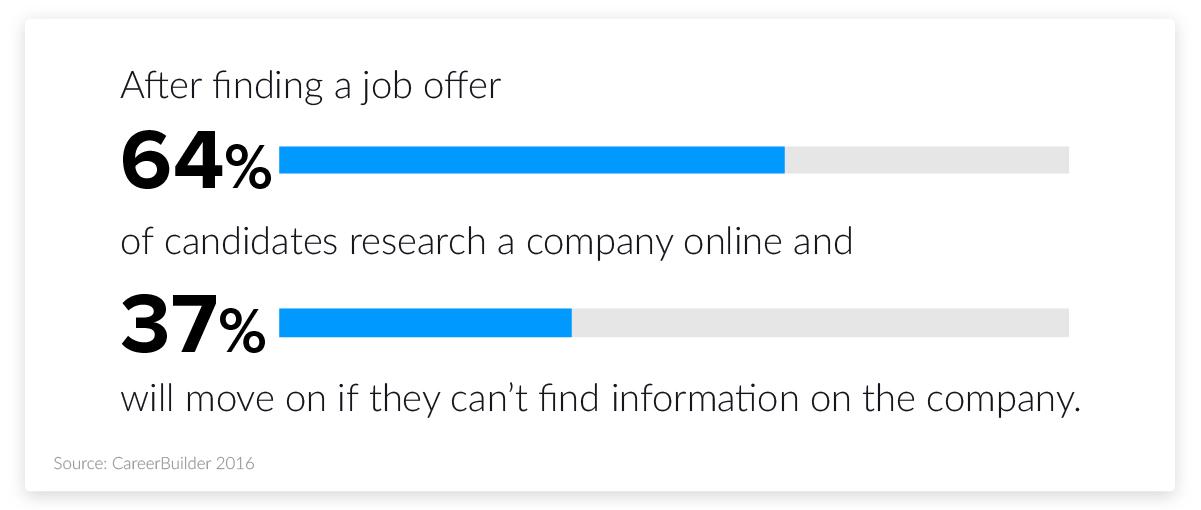
- 50.5% of recruiters say social media has changed their recruiting results.
(2016 Recruiting Benchmark Survey NACE)
- 29% of recruiters are investing in recruiting via social media platforms.
(Jobvite Recruiter Nation Report 2016)
- 60% of recruiters are investing in visitor career websites.
(Jobvite Recruiter Nation Report 2016)
- 28% of recruiters are investing in recruiting via job boards.
(Jobvite Recruiter Nation Report 2016)
- The superlative social media platforms recruiters use to bank check candidates include:
○ LinkedIn - 87%
○ Facebook - 43%
○ Twitter - 22%
○ Weblog - 11%
○ Instagram - 8%
○ Youtube - vi%
○ Snapchat - 3%
(Jobvite Recruiter Nation Study 2016)
- 87% of recruiters use LinkedIn to bank check candidates, but simply 43% use Facebook and 22% Twitter
(Jobvite Recruiter Nation Report 2016)
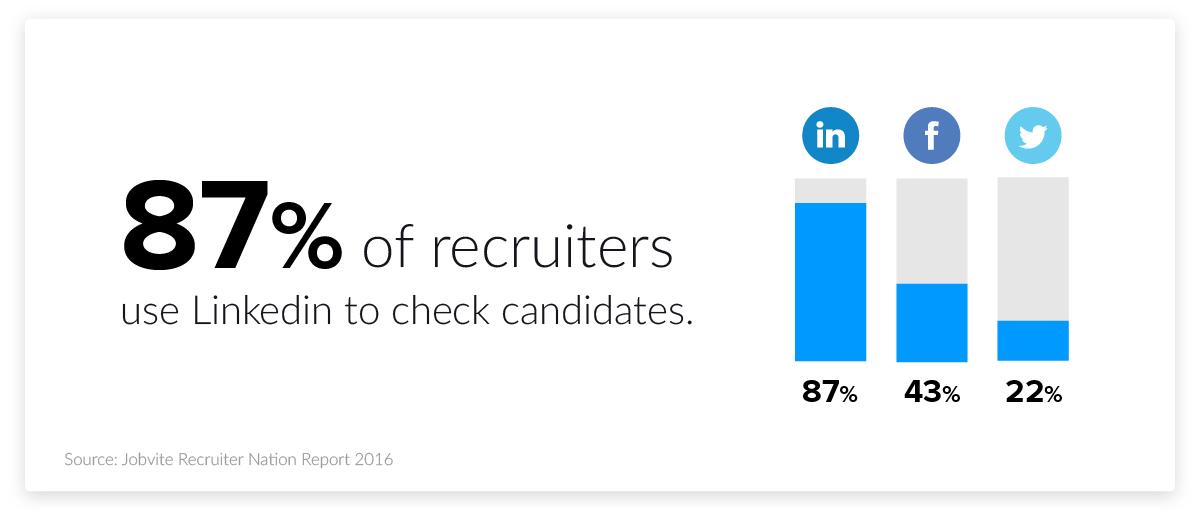
- 67% of social task seekers use Facebook to search for jobs.
(Jobvite Recruiter Nation Written report 2016)
- 60% of recruiters use social networking sites to inquiry candidates.
(Careerbuilder)
- 59% of recruiters use search engines to look up candidates.
(Careerbuilder)
- Recruiters will disqualify candidates if they find bear witness of the following on their social media profiles:
○ Provocative or Inappropriate Content - 46%
○ Alcohol and Drugs - 43%
○ Narrow-minded Content (Race, Organized religion, Gender, etc.) - 33%
○ Bad-mouthing Previous Visitor - 31%
○ Poor Communcation Skills - 29%
(Careerbuilder)
- Recruiters volition disqualify candidates if they find evidence of the post-obit on their social media profiles:
○ Typos - 72%
○ Marijuana - 71%
○ Oversharing - sixty%
○ Booze - 47%
○ Selfies - 18%
(Jobvite Recruiter Nation Report 2016)
- For recruiters over 65, 63% find evidence of booze consumption on social media as negative.
(Jobvite Recruiter Nation Report 2016)
- 41% of employers say that they might not interview a candidate if they tin't find them online.
(Careerbuilder)
- Only 36% of recruiters volition try to add candidates equally friends on a private account. When asked, 68% of job seekers granted permission, which is downwards from 80%.
(Careerbuilder)
- 41% of employers say they research electric current employees on social media, with 32% using search engines.
(Careerbuilder)
- 63% of United states employers expect employees to take social media experience.
(Careerbuilder 2017)
8
Employer Branding Statistics
- 51% of recruiters say that employee branding is the number one investment that they volition increase in the next twelvemonth.
(Jobvite Recruiter Nation Report 2016)
- Employer branding has a significant touch on hiring talent according to lxxx% of recruiters.
(LinkedIn Global Recruiting Trends 2017)
- 46% of Glassdoor members read reviews earlier they speak with a company recruiter or hiring manager.
(Glassdoor Survey September 2013)
- 86% of Glassdoor users read company reviews and ratings before making a decision to apply for a job.
(Glassdoor United states Site Survey January 2020)
- 55% of jobseekers who take read a negative review take decided not to utilize for a job at that company. (CareerArc)
- 36% of employees say a visitor'southward market reputation is "very important" when considering a new chore.
(Gallup Country of the American Workplace Report 2017)
- 39% of women vs. 33% of men say marketplace reputation is "very important" when considering a new job.
(Gallup)
- twoscore% of Millennials say market reputation has the biggest influence on their impression of an employer.
(2017 Millennial Hiring Trends Study MRI Network)
- 69% of job seekers are probable to apply to a task if the employer actively manages its brand (e.chiliad., responds to reviews, updates profiles, shares info on civilization and work environment).
(Glassdoor 2016)
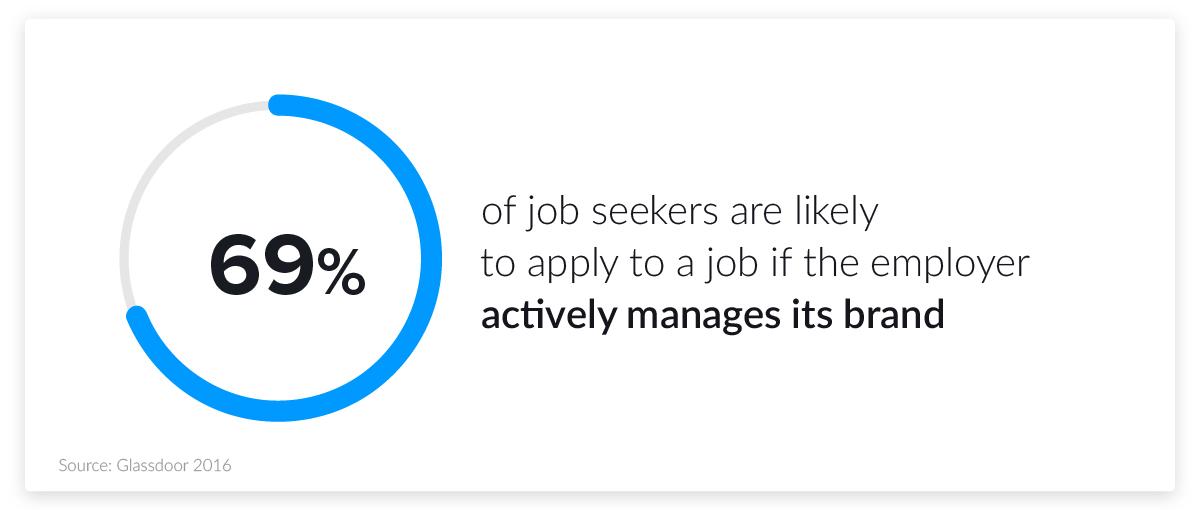
- 62% of Glassdoor users agree that their perception of a company improves after seeing an employer answer to a review.
(Glassdoor US Site Survey January 2016)
- Companies with positive brands go 2x equally many applications as companies with negative brands, and they spend less on employees.
(Betterteam Blog 2017)
- Companies with bad reputations pay x% more per hire.
(Harvard Business Review 2016)
- 50% of candidates say they wouldn't work for a visitor with a bad reputation - even for a pay increase.
(Betterteam Weblog 2017)
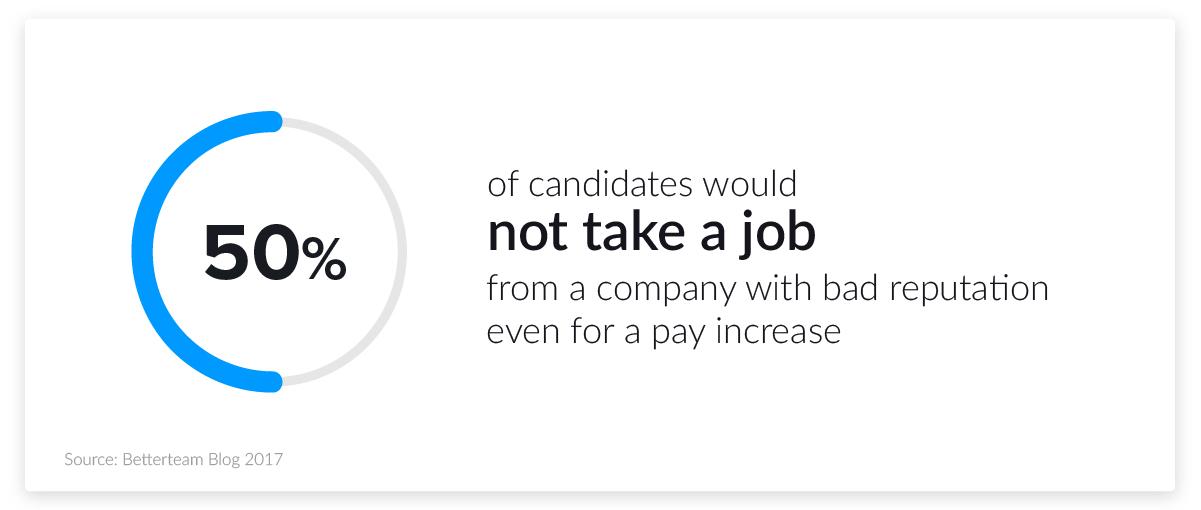
- Only 8% of the recruiting upkeep is spent on employer branding.
(LinkedIn Global Recruiting Trends 2017)
- Given an unlimited budget, 53% of recruiters would invest in employer branding.
(LinkedIn Global Recruiting Trends 2017)
- Organizations that practise invest in employer branding are 3x more likely to brand a quality hire.
(Brandon Hall 2015)
- The majority of job seekers read at to the lowest degree 6 reviews before forming an opinion of a company.
(Glassdoor US Site Survey Jan 2016)
- Fewer than half (49%) of employees would recommend their employer to a friend.
(Glassdoor Data Labs, December 2015)
- Best channels to build an employer brand:
○ My Company'south Career Site - 61%
○ LinkedIn - 55%
○ Tertiary-party Website or Task Lath - 40%
○ Facebook - 35%
○ Campus Recruiting - 31%
(LinkedIn Global Recruiting Trends 2017)
- Virtually iii out of 4 employees say their employer does not (or doesn't know how) to use social media to promote their brand.
(Glassdoor 2013)
- Employed workforce demographics past race:
○ African American - 11.9%
○ Asian - 6.1%
○ Hispanic or Latino - sixteen.seven%
(The states Bureau of Labor Statistics 2016)
- Women make upwards 47% of the overall workforce.
(Pew Research October 2016)
- Women make up 55% of workers holding jobs requiring social skills.
(Pew Inquiry October 2016)
- Women make upward 52% of workers holding jobs requiring belittling skills.
(Pew Research October 2016)
- Men make upwards lxx% of workers holding jobs requiring physical or manual skills.
(Pew Enquiry October 2016)
- 67% of active and passive chore seekers say diversity is important to them when they're evaluating companies and job offers.
(Glassdoor Survey 2014)
- fourscore% of job seekers believe their companies foster diversity at piece of work.
(Jobvite 2017 Job Seeker Nation Written report)
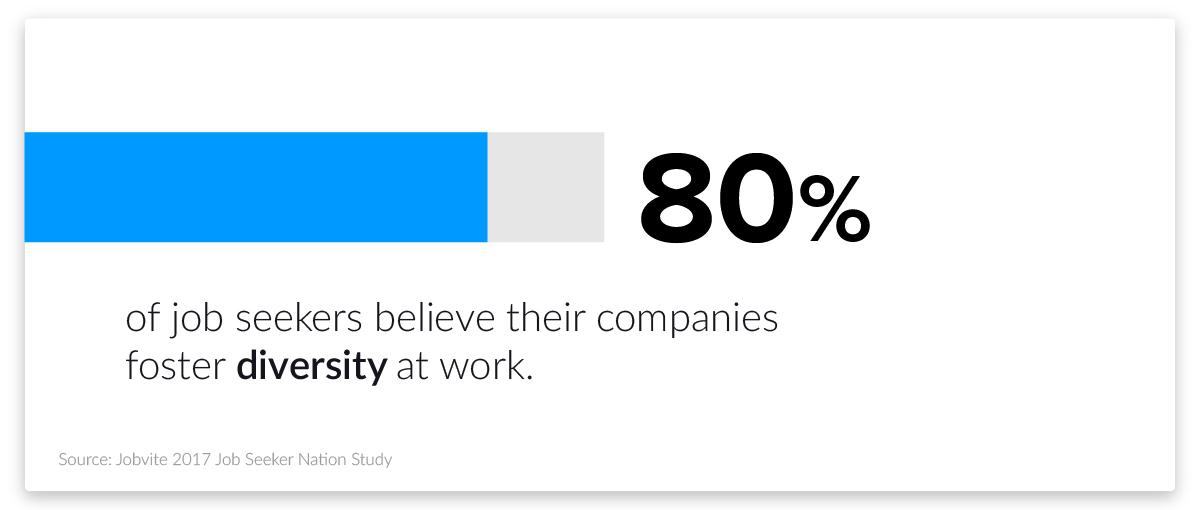
- Here's who thinks multifariousness is "very of import" in the workplace:
○ African Americans - sixty%
○ Hispanics - 43%
○ Women - 36%
○ Asian/Pacific Islanders - 32%
○ Men - 29%
○ Whites - 27%
(Jobvite 2017 Job Seeker Nation Study)
- 32% of task seekers ranked diversity as "important," and 18% as "not important."
(Jobvite 2017 Job Seeker Nation Report)
- 37% of recruiters ranked recruiting more diverse candidates every bit a top trend in the nigh future.
(LinkedIn Global Recruiting Trends 2017)
- In 2015, American women working full time were paid 80% of what their male person counterparts made on average, creating a pay gap of xx%.
(AAUW 2017)
- Women are 82% more likely to believe that men are paid more for the aforementioned work.
(Jobvite 2017 Chore Seeker Nation Study)
- Ethnically diverse companies are 35% more likely to have a fiscal operation in a higher place the industry mean.
(McKinsey 2015)
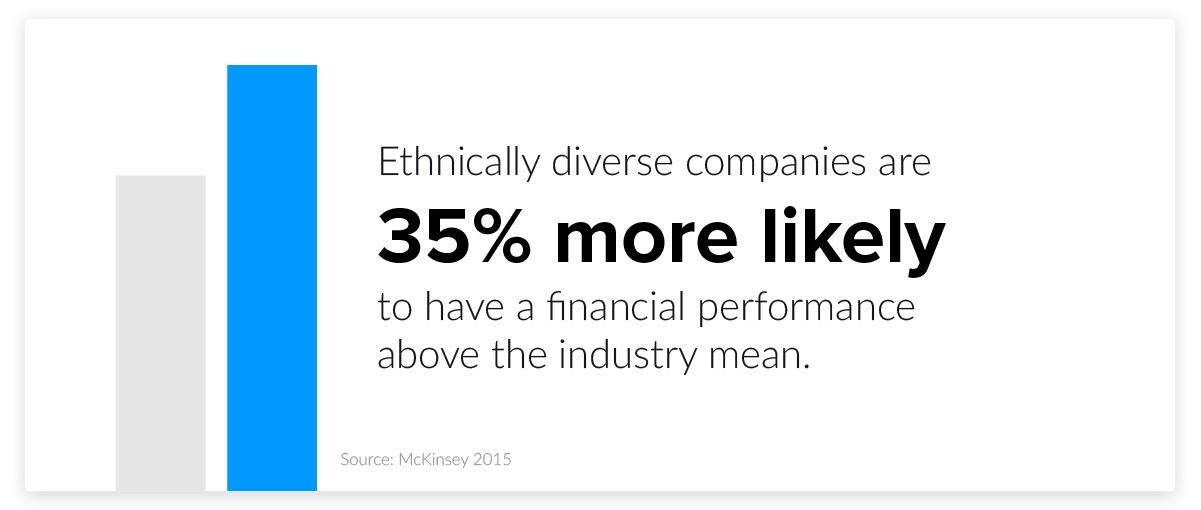
- Gender various companies are 15% more likely to have a financial operation above the industry mean.
(McKinsey 2015)
- Companies with the highest level of ethnical diversity will bring in 15 times more than sales revenue than companies with the everyman level of racial diversity.
(McKinsey 2015)
- Women business relationship for nineteen% of corporate board members in the U.s..
(McKinsey 2017)
- At that place are 32 female CEOs (1 Latina) of Fortune 500 companies up from 21 in 2016, but merely bookkeeping for 6.four% of the list.
(2017 Fortune 500)
- There are only iv African American CEOs (all men) of Fortune 500 companies, accounting for two% of the list.
(2017 Fortune 500)
- Fortune 500 CEOs past Ethnicity and Race:
○ White - 73%
○ Asian - 21%
○ Latino/a - 3%
○ African American - 2%
○ Two or More Races - 0.half dozen%
○ Native American - 0.ii%
○ Hawaiian or Pacific Islander - 0.one%
(2017 Fortune 500)
Learn more from Zety's studies on: ageism, resume bias, political conflict at work.
10
Mobile Recruiting Statistics
- Conducting a phone Interview tin can add 6.8 - 8.two days to the recruitment process.
(Glassdoor)
- In 2014, 48% of chore seekers idea mobile devices would be the most common way to search for jobs past 2017.
(Glassdoor 2014)
- 41% of United states of america employers plan to use text messages to schedule chore interviews.
(Careerbuilder 2017)
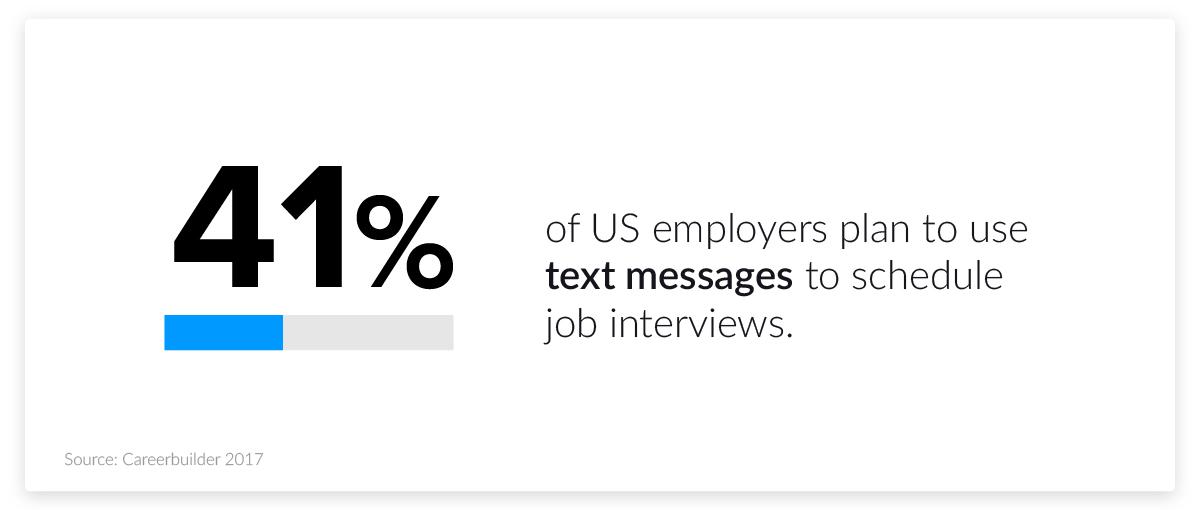
- Only 10% of recruiters were investing in providing applications via mobile in 2016.
(Jobvite Recruiter Nation Report 2016)
- In 2014, 45% of chore seekers said they used their mobile devices to search for jobs at least one time a day.
(Glassdoor 2014)
- By 2016, just 19% of recruiters were investing in a mobile career website.
(Jobvite Recruiter Nation Report 2016)
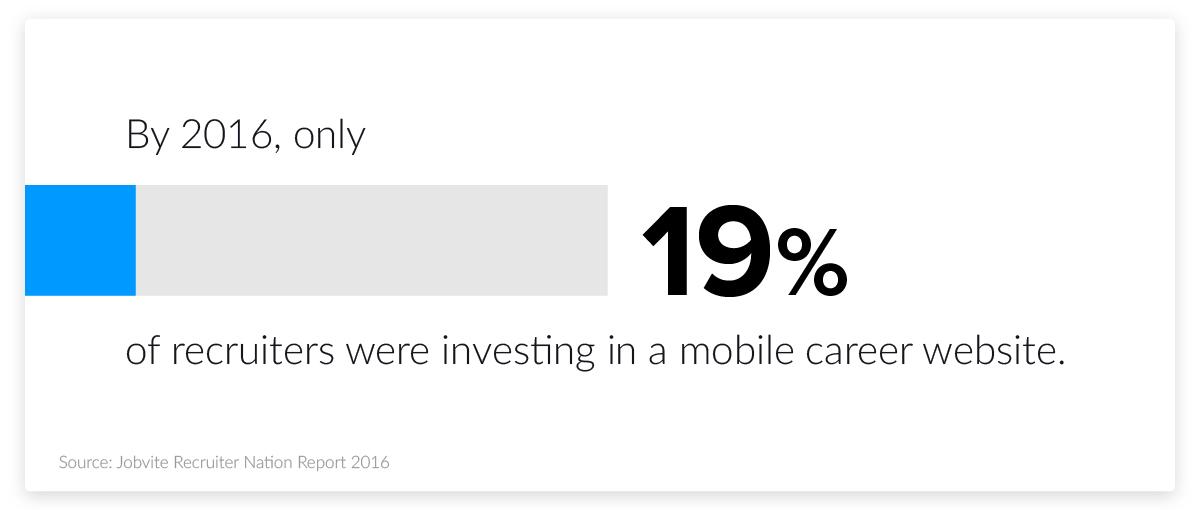
- Mobile task seekers reported searching for jobs in bed (52%), at their current job (37%), or in the restroom (fifteen%)
(Jobvite Recruiter Nation Report 2016)
- In 2014, 89% of job seekers believed a mobile device was an of import tool for the job search.
(Glassdoor 2014)
xi
Students and Recent Graduates Statistics
- It takes the average college graduate iii to six months to secure employment subsequently graduation.(University of Washington 2019)
- In 2016, 44% of new grads wanted to work for medium or small businesses and startups.
(Accenture 2016)
- In 2017, 19% of grads want to work for big companies, up 37% over 2016 grads.
(Gen Z Report Accenture 2017)
- 69% of 2017 grads expect to make more $35,000 a year, only 49% of recent grads make that much.
(Gen Z Report Accenture 2017)
- 66% of 2017 grads believe they can make more than $35,000 a year at big companies vs. 44% at small-scale companies.
(Gen Z Report Accenture 2017)
- 81% of 2017 grads believe they can advance their careers in large companies, vs. 63% in small companies.
(Gen Z Report Accenture 2017)
- 78% of 2017 grads completed an internship or apprenticeship.
(Gen Z Report Accenture 2017)
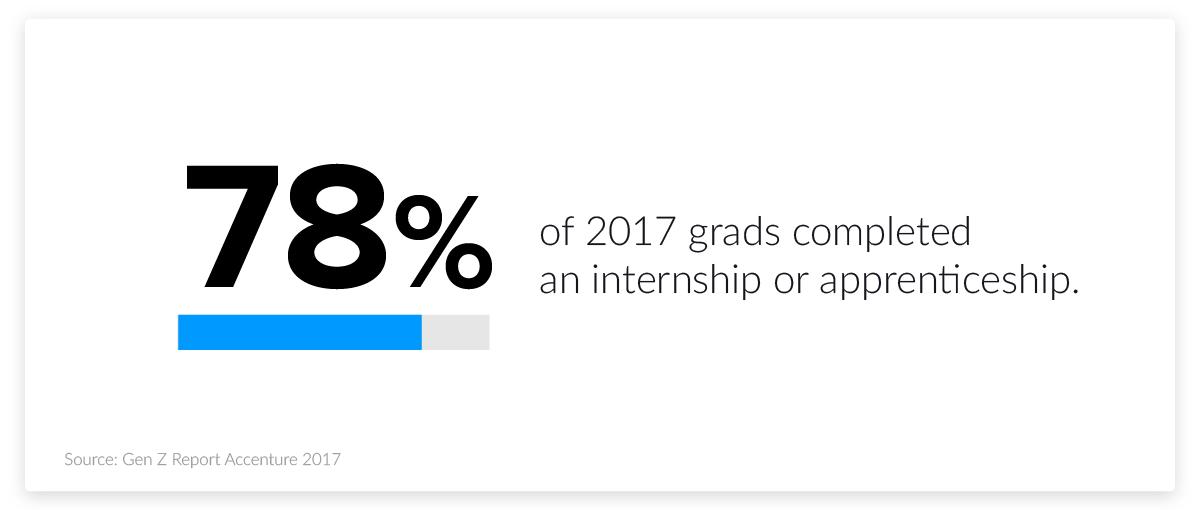
- 72% of 2017 grads believe they tin go grooming at large companies vs. 57% at modest companies.
(Gen Z Report Accenture 2017)
- 29% of 2017 grads believe they will stay 5+ years at a big company vs. 9% at small companies.
(Gen Z Report Accenture 2017)
- Recruiters are hiring recent graduates for:
○ IT Positions - 27%
○ Customer Service - 26%
○ Finance - xix%
○ Business Development - 19%
○ Sales - 17%
(Careerbuilder)
- Recruiters are looking for candidates with the following majors:
○ Business - 35%
○ Calculator and Information Sciences - 23%
○ Engineering science - 18%
○ Math and Statistics - 15%
○ Health Professionals and Related Clinical Sciences - 14%
○ Communications Technologies - eleven%
○ Engineering Technologies - 11%
○ Communication and Journalism - 8%
○ Liberal Arts and Sciences, General Studies, and Humanities - 7%
○ Science Technologies - vii%
○ Social Sciences - six%
○ Biological and Biomedical Sciences - 6%
○ Architecture and Planning - 6%
○ Education - 5%
(Careerbuilder)
- 94% of 2017 grads expect to detect a job in their field of study.
(Gen Z Report Accenture 2017)
- Simply 57% of contempo grads work full-fourth dimension in their field of study.
(Gen Z Report Accenture 2017)
- In 2016, 68% of new grads said they wanted on-the-task learning and 67% got training from their first employer.
(Gen Z Report Accenture 2017)
- 97% of 2017 grads said they will demand on-the-job preparation to farther their careers.
(Gen Z Study Accenture 2017)
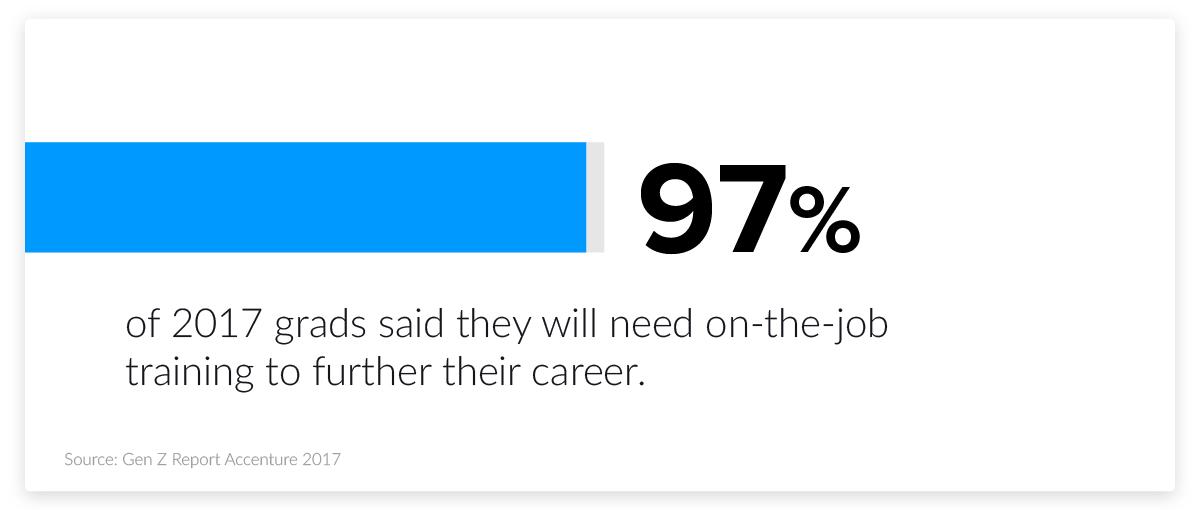
- Only 27% of college graduates are working in a chore straight related to their major. (Undergraduate caste holders)
(Federal Reserve Bank of New York)
- Only 24% of employers feel that new graduates are not prepared for piece of work at all.
(Careerbuilder)
- Recruiters blame missing skills on
○ Book Learning Over Real-earth Learning - 47%
○ No Blend of Technical and Liberal Arts Skills - 39%
○ Non Prepared for the Complexity of Entry-level Roles - 25%
○ No Focus on Internships - 13%
○ Are Up-to-appointment with Technology Changes - thirteen%
○ Wrong Caste - 11%
(Careerbuilder)
- 83% of 2017 grads believe their pedagogy prepared them for their career, but 84% still expect formal preparation.
(Gen Z Report Accenture 2017)
- 54% of recent grads consider themselves underemployed, upwards from 51% in 2016 and 41% in 2013.
(Gen Z Report Accenture 2017)
- Recent grads are 2.5x more than probable to stay for v+ years if they don't feel underemployed and their skills are beingness used.
(Gen Z Report Accenture 2017)
- 2017 grads are flexible about:
○ Relocating for the Chore - 75% (up from 72% in 2016)
○ Weekends and Evening - 58% (up from 52% in 2016)
○ Unpaid Internship in Place of Paid Opening - 71%
(Gen Z Written report Accenture 2017)
- In 2016, 92% of new graduates said that information technology's important that their company is socially responsible.
(Accenture 2016)
Primal Takeaway
Facts, figures, and HR statistics can put your task search into perspective. It's good to know how trigger-happy the competition is and what you're up against whether you're a recruiter or a job seeker. As a chore seeker, it suddenly makes a lot of sense to put the effort and time into your resume when you lot know that hundreds of others likewise applied.
Equally for recruiters, knowing the numbers behind the task search tin can result in huge savings.
Either way, having a tangible sense of what information technology looks like to get a task in today's market place volition give yous the upper hand. And 60 minutes statistics are here to assist.
Let the states know in the comments if there are any other job statistics you'd like to see.
Source: https://zety.com/blog/hr-statistics
0 Response to "How Long Does the Average Employer Spend Reviewing a Cover Letter"
Post a Comment